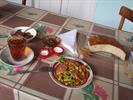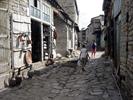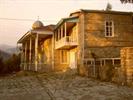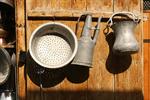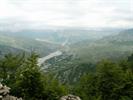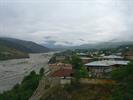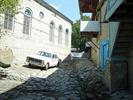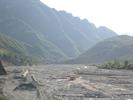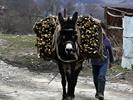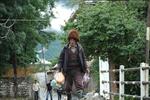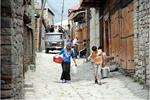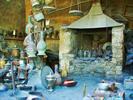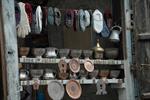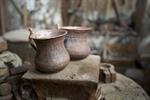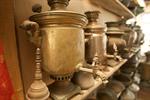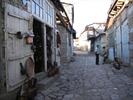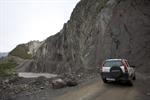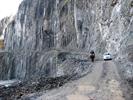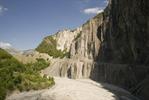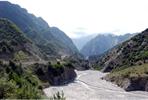Azerbaijan does not have many tourist attractions, but what it does have is plenty of quaint little mountain villages. Many of which were isolated for centuries forcing them to develop their own language and skills. And one of the more famous villages is Lahic.
The quaint little coppersmith village of Lahic is a superb place to sample traditional rural life. And the experience is made richer, as several Lahici youths speak English, with more returning from Baku in summer (July to mid-September) to act as guides.
History
Older villagers speak a dialect that is nearer to Farsi than Azeri and claim that Lahic is named for the Persian-Caspian town of Lahijun from which their ancestors supposedly emigrated a millennium ago, bringing with them their famous coppersmithing skills. In its 19th-century heyday, Lahic boasted around 200 craftsmen, and Lahic carpets and metalwork fetched high prices in the bazaars of Baghdad. The population was around 15,000 until WWII, when the privations of war led many to starve or flee across the mountains: the road wasn't built until the 1960s. During 2008-2009 the planned introduction of piped water in Lahic caused a great improvement in people’s lives. However, it means the end to the photogenic sight of women filling their guyum (traditional copper water vessels) at the village’s many springs.
ORIENTATION & INFORMATION
Lahic starts where the road from Ismayilly fords the Kishlarcay stream in front of the Cannat Bagy Guest House. The road then snakes along a cliff top past the Ismayilly bus stop (150m) and over a small stone bridge to the triangular central square marked by a war memorial (300m). From here the cobbled main street (Huseynov kuc) passes a series of coppersmith workshops before crossing the Lulochay stream on another bridge after around 700m. The road then continues a similar distance on the far side through a less commercial part of town known as Aracit.
Incredibly, little Lahic has what is probably Azerbaijan's best-functioning tourist office (www.lahijtur.az; Nizami str; 10am-2pm
& 3-7pm Jun–mid-Sep). It organises homestays, guides and horse rentals and sells basic maps (AZN1) and photo CDs (AZN2) to fund its existence. To find the tourist office walk along the main street to the tiny Internet Klub (40 Huseynov str) and turn right up the narrow alley beyond, climbing steps up to Nizami str. Then turn right again.
SIGHTS & ACTIVITIES
The village is, at best, around 2,000 people. They speak there own language, although Azeri and Russian can still be heard (with the occasional foreign language). The one thing you're unlikely to hear is the wind and grind of city life. Instead it's the gentle tapping sound that spills from workshops along its roughly cobbled streets that fills the ears. Here in Lahic, centuries of isolation have honed the skills of the copper smiths which line the narrow streets. The soaring peaks that surround this village make farming nearly impossible, so local people turned very long ago to crafts. Copper smithing is only the most famous. Almost everyone who lives here can turn shapeless things into objects of quiet and even mystic beauty. Carpet weaving, wood carving and a variety of other such handy crafts await the weary traveller.
Lahic is particularly famous for its coppersmiths, whose workshops overflow into narrow, stone-paved Huseynov kuc. On the upper floors of the workshops you can sometimes still find carpet makers at work. As years go by the workshops are increasingly transforming themselves into tourist boutiques but they remain rustic, welcoming places, where craftsmen are happy to be watched and photographed engraving intricate patterns. High global copper prices and growing tourist savvy mean that copperware is not as inexpensive as it used to be, but there are still some relative bargains to be had if you shop around.
Local Coppersmiths are renowned for producing high quality products and they can be viewed at work in many of the small workshops along the main road. Whereas Xinaliq had the jaw dropping scenery, Lahic will be remembered for its wonderful stone houses and narrow cobbled streets. If you put Lahic's houses in Xinaliq's location, you would probably have the most beautiful place on Earth.
Horses are still being ridden through the streets, whilst cows meander down other thoroughfares. At times there is certainly the feeling of stepping back in time.
For those who is not limited in time a return walk down from Xinalyg to Ismayilly might be an excellent idea to take a fantastic walk and to keep the memories of this amazing place. The walk is all downhill and will offer some breathtaking views, as cliffs sprout from the valley basin, where a river snaked its way down from the mountains. You can walk the entire length of the valley within 3-4 hours or catch a passing bus/taxi when you get tired. Budget backpackers really should take LP's 'guidance' with a pinch of salt, as nine times out of ten there is a cheaper and more enjoyable way of travelling.
The quaint little one-room Lahic History Museum (Nizami kuc; donation expected; 9am-8pm) is housed in a former mosque next door to the tourist office. It displays a typical selection of traditional cooking and farming instruments, ancient weapons and pottery, plus painted portraits of local artists and writers, a disproportionate number for such a tiny place. The village school is also open to the curious during the summer, and it's better appointed than most others you’re likely to see in Azerbaijan.
One of the joys of Lahic is hiking up the steep wooded hillsides towards the bare mountaintop sheep meadows (yaylag) where flocks graze in summer and views towards the snow-topped high Caucasus can be magnificent on a clear day. Of the region's (very) ruined fortresses, the most accessible is Niyal Qalasi, about 1,5 hours sweaty climb up the Kishchay valley. With a horse and guide you could make a two-day excursion to more impressive Fit Dag castle. The tourist office can offer many more suggestions.
GETTING THERE & AWAY
The dirt road to Lahic winds up the Girdimanchai river gorge from the vineyards outside Semaka, crossing the "torrent" (more like a trickle) on a flimsy bridge (more like flimsy) and skirting the sheer walls on narrow, roughly hewn ledges. The drive has some spectacular sections with perilous drops, geological wizardry and a couple of attractive villages en route. Ice and snow cut Lahic off from the valley for weeks at a time in winter and washouts are common in heavy spring rains. The drive up to Lahic is as stunning as dangerous, animals appear out of nowhere in winding 'roads' that hug the cliff face that plunges down into the valley below. Best of all, you can do it in a centuries old bus, for about $2, from the village on Ismailli. Buses to Ismayilly leave at 8.30am, 12.30pm and 4pm. A direct marshrutka from Lahic to Baku (four hours) departs around 8am from the central square. Ask the driver to save you a seat the night before.
If you're planning a trip to Azerbaijan you may be interested ▶ Azerbaijan highlights - For those who prefer to go unbeaten path, to explore less visited places and check national charisma of this small country in Southern Caucasus on the edge of Europe.




